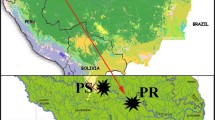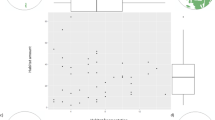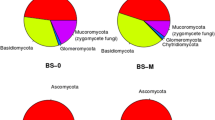Abstract
Little is known of how soil archaeal community composition and diversity differ between local variants of tropical rainforests. We hypothesized that (1) as with plants, animals, fungi, and bacteria, the soil archaeal community would differ between different variants of tropical forest; (2) that spatially rarer forest variants would have a less diverse archaeal community than common ones; (3) that a history of forest disturbance would decrease archaeal alpha- and beta-diversity; and (4) that archaeal distributions within the forest would be governed more by deterministic than stochastic factors. We sampled soil across several different forest types within Brunei, Northwest Borneo. Soil DNA was extracted, and the 16S rRNA gene of archaea was sequenced using Illumina MiSeq. We found that (1) as hypothesized, there are distinct archaeal communities for each forest type, and community composition significantly correlates with soil parameters including pH, organic matter, and available phosphorous. (2) As hypothesized, the “rare” white sand forest variants kerangas and inland heath had lower archaeal diversity. A nestedness analysis showed that archaeal community in inland heath and kerangas was mainly a less diverse subset of that in dipterocarp forests. However, primary dipterocarp forest had the lowest beta-diversity among the other tropical forest types. (3) Also, as predicted, forest disturbance resulted in lower archaeal alpha-diversity—but increased beta-diversity in contrast with our predictions. (4) Contrary to our predictions, the BetaNTI of the various primary forest types indicated community assembly was mainly stochastic. The possible effects of these habitat and disturbance-related effects on N cycling should be investigated.






Similar content being viewed by others
References
Corlett RT (2014) The ecology of tropical East Asia. Oxford University Press, UK
Whitmore T (1984) Tropical rain forests of the Par East. Oxford University Press, Oxford
Tripathi BM, Song W, Slik J, Sukri RS, Jaafar S, Dong K, Adams JM (2016) Distinctive tropical forest variants have unique soil microbial communities, but not always low microbial diversity. Front Microbiol 7
Woese CR, Kandler O, Wheelis ML (1990) Towards a natural system of organisms: proposal for the domains Archaea, Bacteria, and Eucarya. Proc Natl Acad Sci 87:4576–4579
Bates ST, Berg-Lyons D, Caporaso JG, Walters WA, Knight R, Fierer N (2011) Examining the global distribution of dominant archaeal populations in soil. ISME J 5:908
Bengtson P, Sterngren AE, Rousk J (2012) Archaeal abundance across a pH gradient in an arable soil and its relationship to bacterial and fungal growth rates. Appl Environ Microbiol 78:5906–5911
Cao P, Zhang L-M, Shen J-P, Zheng Y-M, Di HJ, He J-Z (2012) Distribution and diversity of archaeal communities in selected Chinese soils. FEMS Microbiol Ecol 80:146–158
Tripathi BM, Kim M, Lai-Hoe A, Shukor NA, Rahim RA, Go R, Adams JM (2013) pH dominates variation in tropical soil archaeal diversity and community structure. FEMS Microbiol Ecol 86:303–311
Prosser JI, Nicol GW (2008) Relative contributions of archaea and bacteria to aerobic ammonia oxidation in the environment. Environ Microbiol 10:2931–2941
Singh D, Takahashi K, Park J, Adams JM (2016) Similarities and contrasts in the archaeal community of two Japanese mountains: Mt. Norikura compared to Mt. Fuji. Microb Ecol 71:428–441
Tripathi BM, Kim M, Tateno R, Kim W, Wang J, Lai-Hoe A, Shukor NAA, Rahim RA, Go R, Adams JM (2015) Soil pH and biome are both key determinants of soil archaeal community structure. Soil Biol Biochem 88:1–8
He J-Z, Hu H-W, Zhang L-M (2012) Current insights into the autotrophic thaumarchaeal ammonia oxidation in acidic soils. Soil Biol Biochem 55:146–154
Zhang L-M, Hu H-W, Shen J-P, He J-Z (2012) Ammonia-oxidizing archaea have more important role than ammonia-oxidizing bacteria in ammonia oxidation of strongly acidic soils. ISME J 6:1032
Angel R, Soares MIM, Ungar ED, Gillor O (2010) Biogeography of soil archaea and bacteria along a steep precipitation gradient. ISME J 4:553
Nicol GW, Leininger S, Schleper C, Prosser JI (2008) The influence of soil pH on the diversity, abundance and transcriptional activity of ammonia oxidizing archaea and bacteria. Environ Microbiol 10:2966–2978
Singh D, Takahashi K, Adams JM (2012) Elevational patterns in archaeal diversity on Mt. Fuji. PLoS One 7:e44494
Shi Y, Adams JM, Ni Y, Yang T, Jing X, Chen L, He J-S, Chu H (2016) The biogeography of soil archaeal communities on the eastern Tibetan Plateau. Sci Rep 6
Katagiri S, Yamakura T, Lee SH (1991) Properties of soils in kerangas forest on sandstone at Bako National Park, Sarawak, East Malaysia
Proctor J (1999) Heath forests and acid soils. Bot J Scotl 51:1–14
Moran JA, Barker MG, Moran AJ, Becker P, Ross SM (2000) A comparison of the soil water, nutrient status, and litterfall characteristics of tropical heath and mixed-dipterocarp forest sites in Brunei. Biotropica 32:2–13
Din H, Metali F, Sukri RS (2015) Tree diversity and community composition of the Tutong white sands, Brunei Darussalam: a rare tropical heath forest ecosystem. Int J Ecol 2015
Könneke M, Bernhard AE, de La Torre JR, Walker CB (2005) Isolation of an autotrophic ammonia-oxidizing marine archaeon. Nature 437:543
Treusch AH, Leininger S, Kletzin A, Schuster SC, Klenk HP, Schleper C (2005) Novel genes for nitrite reductase and Amo-related proteins indicate a role of uncultivated mesophilic crenarchaeota in nitrogen cycling. Environ. Microbiol. 7:1985–1995
Lipp JS, Morono Y, Inagaki F, Hinrichs K-U (2008) Significant contribution of Archaea to extant biomass in marine subsurface sediments. Nature 454:991
Thauer RK (2011) Anaerobic oxidation of methane with sulfate: on the reversibility of the reactions that are catalyzed by enzymes also involved in methanogenesis from CO 2. Curr Opin Microbiol 14:292–299
Thauer RK, Kaster A-K, Seedorf H, Buckel W, Hedderich R (2008) Methanogenic archaea: ecologically relevant differences in energy conservation. Nat Rev Microbiol 6:579–591
Lee-Cruz L, Edwards DP, Tripathi BM, Adams JM (2013) Impact of logging and forest conversion to oil palm plantations on soil bacterial communities in Borneo. Appl Environ Microbiol 79:7290–7297
Kerfahi D, Tripathi BM, Lee J, Edwards DP, Adams JM (2014) The impact of selective-logging and forest clearance for oil palm on fungal communities in Borneo. PLoS One 9:e111525
Tripathi BM, Edwards DP, Mendes LW, Kim M, Dong K, Kim H, Adams JM (2016) The impact of tropical forest logging and oil palm agriculture on the soil microbiome. Mol Ecol 25:2244–2257
Edwards DP, Larsen TH, Docherty TD, Ansell FA, Hsu WW, Derhé MA, Hamer KC, Wilcove DS (2011) Degraded lands worth protecting: the biological importance of Southeast Asia’s repeatedly logged forests. P Roy Soc London B: Biol Sci 278:82–90
Gibson L, Lee TM, Koh LP, Brook BW, Gardner TA, Barlow J, Peres CA, Bradshaw CJ, Laurance WF, Lovejoy TE (2011) Primary forests are irreplaceable for sustaining tropical biodiversity. Nature 478:378
Wang J, Shen J, Wu Y, Tu C, Soininen J, Stegen JC, He J, Liu X, Zhang L, Zhang E (2013) Phylogenetic beta diversity in bacterial assemblages across ecosystems: deterministic versus stochastic processes. ISME J 7:1310
Stegen JC, Freestone AL, Crist TO, Anderson MJ, Chase JM, Comita LS, Cornell HV, Davies KF, Harrison SP, Hurlbert AH (2013) Stochastic and deterministic drivers of spatial and temporal turnover in breeding bird communities. Glob Ecol Biogeogr 22:202–212
Stegen JC, Lin X, Konopka AE, Fredrickson JK (2012) Stochastic and deterministic assembly processes in subsurface microbial communities. ISME J 6:1653
Hu W, Zhang Q, Tian T, Li D, Cheng G, Mu J, Wu Q, Niu F, Stegen JC, An L (2015) Relative roles of deterministic and stochastic processes in driving the vertical distribution of bacterial communities in a permafrost core from the Qinghai-Tibet Plateau, China. PLoS One 10:e0145747
Wu Y, Xiang Y, Wang J, Zhong J, He J, Wu QL (2010) Heterogeneity of archaeal and bacterial ammonia-oxidizing communities in Lake Taihu, China. Environ Microbiol Rep 2:569–576
Alves RJE, Wanek W, Zappe A, Richter A, Svenning MM, Schleper C, Urich T (2013) Nitrification rates in Arctic soils are associated with functionally distinct populations of ammonia-oxidizing archaea. ISME J 7:1620
Liu S, Shen L, Lou L, Tian G, Zheng P, Hu B (2013) Spatial distribution and factors shaping the niche segregation of ammonia-oxidizing microorganisms in the Qiantang River, China. Appl Environ Microbiol 79:4065–4071
Miyamoto K, Suzuki E, Kohyama T, Seino T, Mirmanto E, Simbolon H (2003) Habitat differentiation among tree species with small-scale variation of humus depth and topography in a tropical heath forest of Central Kalimantan, Indonesia. J Trop Ecol 19:43–54
Proctor J, Anderson J, Chai P, Vallack H (1983) Ecological studies in four contrasting lowland rain forests in Gunung Mulu National Park, Sarawak: I. Forest environment, structure and floristics. J Ecol:237–260
Adeney JM, Christensen NL, Vicentini A, Cohn-Haft M (2016) White-sand ecosystems in Amazonia. Biotropica 48:7–23
Whitmore T, Flenley J, Harris D (1982) The tropics as the norm in biogeography? Geogr J 148:8–18
Huston MA, Huston MA (1994) Biological diversity: the coexistence of species. Cambridge University Press
McGrath DA, Smith CK, Gholz HL, de Assis Oliveira F (2001) Effects of land-use change on soil nutrient dynamics in Amazonia. Ecosystems 4:625–645
Murty D, Kirschbaum MU, Mcmurtrie RE, Mcgilvray H (2002) Does conversion of forest to agricultural land change soil carbon and nitrogen? A review of the literature. Glob Chang Biol 8:105–123
Davies SJ, Becker P (1996) Floristic composition and stand structure of mixed dipterocarp and heath forests in Brunei Darussalam. J Trop For Sci: 542–569
Becker P (1992) Seasonality of rainfall and drought in Brunei Darussalam. Brunei museum. Journal 7:99–109
David A, Sidup S (1996) Brunei metereological services, updated 2008, Climate of Brunei Darussalam
Fierer N, Schimel JP, Holden PA (2003) Variations in microbial community composition through two soil depth profiles. Soil Biol. Biochem. 35:167–176
Fontaine S, Barot S, Barré P, Bdioui N, Mary B, Rumpel C (2007) Stability of organic carbon in deep soil layers controlled by fresh carbon supply. Nature 450:277
Comeau AM, Li WK, Tremblay J-É, Carmack EC, Lovejoy C (2011) Arctic Ocean microbial community structure before and after the 2007 record sea ice minimum. PLoS One 6:e27492
Allen SE, Grimshaw HM, Parkinson JA, Quarmby C (1974) Chemical analysis of ecological materials. Blackwell Scientific Publications
Schloss PD, Westcott SL, Ryabin T, Hall JR, Hartmann M, Hollister EB, Lesniewski RA, Oakley BB, Parks DH, Robinson CJ (2009) Introducing mothur: open-source, platform-independent, community-supported software for describing and comparing microbial communities. Appl Environ Microbiol 75:7537–7541
Masella AP, Bartram AK, Truszkowski JM, Brown DG, Neufeld JD (2012) PANDAseq: paired-end assembler for illumina sequences. BMC Bioinformatics 13:31
Huse SM, Welch DM, Morrison HG, Sogin ML (2010) Ironing out the wrinkles in the rare biosphere through improved OTU clustering. Environ Microbiol 12:1889–1898
Edgar RC, Haas BJ, Clemente JC, Quince C, Knight R (2011) UCHIME improves sensitivity and speed of chimera detection. Bioinformatics 27:2194–2200
Kim O-S, Cho Y-J, Lee K, Yoon S-H, Kim M, Na H, Park S-C, Jeon YS, Lee J-H, Yi H (2012) Introducing EzTaxon-e: a prokaryotic 16S rRNA gene sequence database with phylotypes that represent uncultured species. Int J Syst Evol Microbiol 62:716–721
Meyer F, Paarmann D, D'Souza M, Olson R, Glass EM, Kubal M, Paczian T, Rodriguez A, Stevens R, Wilke A (2008) The metagenomics RAST server—a public resource for the automatic phylogenetic and functional analysis of metagenomes. BMC bioinformatics 9:386
Oksanen J, Kindt R, Legendre P, O’Hara B, Stevens MHH, Oksanen MJ, Suggests M (2007) The vegan package. Community ecology package 10:631–637
Rodríguez-Gironés MA, Santamaría L (2006) A new algorithm to calculate the nestedness temperature of presence–absence matrices. J Biogeogr 33:924–935
Geel M, Ceustermans A, Hemelrijck W, Lievens B, Honnay O (2015) Decrease in diversity and changes in community composition of arbuscular mycorrhizal fungi in roots of apple trees with increasing orchard management intensity across a regional scale. Mol Ecol 24:941–952
McDonald JH (2009) Handbook of biological statistics. Sparky House Publishing, Baltimore
Webb CO, Ackerly DD, Kembel SW (2008) Phylocom: software for the analysis of phylogenetic community structure and trait evolution. Bioinformatics 24:2098–2100
Lauber CL, Strickland MS, Bradford MA, Fierer N (2008) The influence of soil properties on the structure of bacterial and fungal communities across land-use types. Soil Biol. Biochem. 40:2407–2415
Tripathi BM, Kim M, Singh D, Lee-Cruz L, Lai-Hoe A, Ainuddin A, Go R, Rahim RA, Husni M, Chun J (2012) Tropical soil bacterial communities in Malaysia: pH dominates in the equatorial tropics too. Microb Ecol 64:474–484
Cornejo FH, Varela A, Wright SJ (1994) Tropical forest litter decomposition under seasonal drought: nutrient release, fungi and bacteria. Oikos:183–190
Dong K, Kim W-S, Tripathi BM, Adams J (2015) Generalized soil Thaumarchaeota community in weathering rock and Saprolite. Microb Ecol 69:356–360
Siles JA, Margesin R (2016) Abundance and diversity of bacterial, archaeal, and fungal communities along an altitudinal gradient in alpine forest soils: what are the driving factors? Microb Ecol 72:207–220
Stahl DA, de la Torre JR (2012) Physiology and diversity of ammonia-oxidizing archaea. Annu Rev Microbiol 66:83–101
Tupinambá DD, Cantão ME, Costa OYA, Bergmann JC, Kruger RH, Kyaw CM, Barreto CC, Quirino BF (2016) Archaeal community changes associated with cultivation of Amazon Forest soil with oil palm. Archaea 2016
Zhong W, Cai Z (2007) Long-term effects of inorganic fertilizers on microbial biomass and community functional diversity in a paddy soil derived from quaternary red clay. Appl Soil Ecol 36:84–91
Auguet J-C, Casamayor EO (2013) Partitioning of Thaumarchaeota populations along environmental gradients in high mountain lakes. FEMS Microbiol Ecol 84:154–164
Pedneault E, Galand PE, Potvin M, Tremblay J-É, Lovejoy C (2014) Archaeal amoA and ureC genes and their transcriptional activity in the Arctic Ocean. Sci Rep 4
Nicol GW, Campbell CD, Chapman SJ, Prosser JI (2007) Afforestation of moorland leads to changes in crenarchaeal community structure. FEMS Microbiol Ecol 60:51–59
Nicol GW, Tscherko D, Embley TM, Prosser JI (2005) Primary succession of soil Crenarchaeota across a receding glacier foreland. Environ Microbiol 7:337–347
Fierer N (2017) Embracing the unknown: disentangling the complexities of the soil microbiome. Nat Rev Microbiol
Chase JM (2010) Stochastic community assembly causes higher biodiversity in more productive environments. Science 328:1388–1391
Rodrigues JL, Pellizari VH, Mueller R, Baek K, Jesus EC, Paula FS, Mirza B, Hamaoui GS, Tsai SM, Feigl B (2013) Conversion of the Amazon rainforest to agriculture results in biotic homogenization of soil bacterial communities. Proc Natl Acad Sci 110:988–993
Carvalho TS, Jesus EC, Barlow J, Gardner TA, Soares IC, Tiedje JM, Moreira FMS (2016) Land use intensification in the humid tropics increased both alpha and beta diversity of soil bacteria. Ecology 97:2760–2771
Fine PV, García-Villacorta R, Pitman NC, Mesones I, Kembel SW (2010) A floristic study of the white-sand forests of Peru. Ann Mo Bot Gard 97:283–305
Phillips O, Miller JS (2002) Global patterns of plant diversity: Alwyn H. Gentry’s forest transect data set. Missouri Botanical Press
Edwards DP, Hodgson JA, Hamer KC, Mitchell SL, Ahmad AH, Cornell SJ, Wilcove DS (2010) Wildlife-friendly oil palm plantations fail to protect biodiversity effectively. Conser Lett 3:236–242
Acosta-Martínez V, Dowd S, Sun Y, Allen V (2008) Tag-encoded pyrosequencing analysis of bacterial diversity in a single soil type as affected by management and land use. Soil Biol Biochem 40:2762–2770
Shange RS, Ankumah RO, Ibekwe AM, Zabawa R, Dowd SE (2012) Distinct soil bacterial communities revealed under a diversely managed agroecosystem. PLoS One 7:e40338
Acknowledgments
This work was supported by a grant from the National Research Foundation (NRF) funded by the Korean Government, Ministry of Education, Science and Technology (MEST) (NRF-0409-20150076). We thank the Brunei Forestry Department and the Biodiversity Research and Innovation Centre for entry and export permits, respectively, and the Universiti Brunei Darussalam for permission to conduct research.
Author information
Authors and Affiliations
Corresponding author
Electronic Supplementary Material
ESM 1
(DOCX 430 kb)
Rights and permissions
About this article
Cite this article
Kerfahi, D., Tripathi, B.M., Slik, J.W.F. et al. Distinctive Soil Archaeal Communities in Different Variants of Tropical Equatorial Forest. Microb Ecol 76, 215–225 (2018). https://doi.org/10.1007/s00248-017-1118-4
Received:
Accepted:
Published:
Issue Date:
DOI: https://doi.org/10.1007/s00248-017-1118-4




